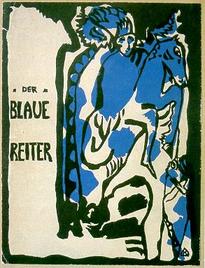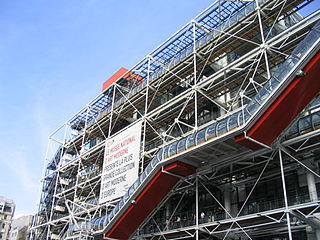
Modern art includes artistic work produced during the period extending roughly from the 1860s to the 1970s, and denotes the styles and philosophies of the art produced during that era. The term is usually associated with art in which the traditions of the past have been thrown aside in a spirit of experimentation. Modern artists experimented with new ways of seeing and with fresh ideas about the nature of materials and functions of art. A tendency away from the narrative, which was characteristic of the traditional arts, toward abstraction is characteristic of much modern art. More recent artistic production is often called contemporary art or postmodern art.
This page indexes the individual year in art pages; see also art periods. This list is exclusively for the visual arts; for music, see Timeline of musical events.

Events from the year 1911 in art.

Der Blaue Reiter was a group of artists and a designation by Wassily Kandinsky and Franz Marc for their exhibition and publication activities, in which both artists acted as sole editors in the almanac of the same name, first published in mid-May 1912. The editorial team organized two exhibitions in Munich in 1911 and 1912 to demonstrate their art-theoretical ideas based on the works of art exhibited. Traveling exhibitions in German and other European cities followed. The Blue Rider disbanded at the start of World War I in 1914.

The Musée National d'Art Moderne is the national museum for modern art of France. It is located in Paris and is housed in the Centre Pompidou in the 4th arrondissement of the city. In 2021 it ranked 10th in the list of most visited art museums in the world, with 1,501,040 visitors. It is one of the largest museums for modern and contemporary art.
Abstract Imagists is a term derived from a 1961 exhibition in the Guggenheim Museum, New York called American Abstract Expressionists and Imagists. This exhibition was the first in the series of programs for the investigation of tendencies in American and European painting and sculpture.

The Russian avant-garde was a large, influential wave of avant-garde modern art that flourished in the Russian Empire and the Soviet Union, approximately from 1890 to 1930—although some have placed its beginning as early as 1850 and its end as late as 1960. The term covers many separate, but inextricably related, art movements that flourished at the time; including Suprematism, Constructivism, Russian Futurism, Cubo-Futurism, Zaum, Imaginism, and Neo-primitivism. In Ukraine, many of the artists who were born, grew up or were active in what is now Belarus and Ukraine, are also classified in the Ukrainian avant-garde.

Vladimir Davidovich Baranov-Rossiné, also spelled Baranoff-Rossiné, born Shulim Wolf Leib Baranov, was a painter and sculptor active in Russia and France. His work belonged to the avant-garde movement of Cubo-Futurism. He was also an inventor.

Kestner Gesellschaft is an art institution in Hanover, Germany, founded in 1916 to promote the arts. Its founders included the painter Wilhelm von Debschitz (1871–1948). The association blossomed under the management of Alexander Dorner and Justus Bier, pioneering modern art.
Atelier 17 was an art school and studio that was influential in the teaching and promotion of printmaking in the 20th century. Originally located in Paris, the studio relocated to New York during the years surrounding World War II. It moved back to Paris in 1950.

20th-century Western painting begins with the heritage of late-19th-century painters Vincent van Gogh, Paul Cézanne, Paul Gauguin, Georges Seurat, Henri de Toulouse-Lautrec, and others who were essential for the development of modern art. At the beginning of the 20th century, Henri Matisse and several other young artists including the pre-cubist Georges Braque, André Derain, Raoul Dufy and Maurice de Vlaminck, revolutionized the Paris art world with "wild", multi-colored, expressive landscapes and figure paintings that the critics called Fauvism. Matisse's second version of The Dance signified a key point in his career and in the development of modern painting. It reflected Matisse's incipient fascination with primitive art: the intense warm color of the figures against the cool blue-green background and the rhythmical succession of the dancing nudes convey the feelings of emotional liberation and hedonism.

Ukrainian avant-garde is the avant-garde movement in Ukrainian art from the end of 1890s to the middle of the 1930s along with associated artists in sculpture, painting, literature, cinema, theater, stage design, graphics, music, and architecture. Some well-known Ukrainian avant-garde artists include: Kazimir Malevich, Alexander Archipenko, Vladimir Tatlin, Sonia Delaunay, Vasyl Yermylov, Alexander Bogomazov, Aleksandra Ekster, David Burliuk, Vadym Meller, and Anatol Petrytsky. All were closely connected to the Ukrainian cities of Kyiv, Kharkiv, Lviv, and Odesa by either birth, education, language, national traditions or identity. Since it originated when Ukraine was part of the Russian Empire, Ukrainian avant-garde has been commonly lumped by critics into the Russian avant-garde movement.

The Museo Botero, also known as the Botero Museum, is an art museum located in La Candelaria neighborhood of Bogotá, Colombia. It houses mostly works by Colombian artist Fernando Botero, however it also includes artwork by other international artist that were of Botero's own private art collection.

documenta 8 was the eighth edition of documenta, a quinquennial contemporary art exhibition. It was held between 12 June and 20 September 1987 in Kassel, West Germany. The artistic director was Manfred Schneckenburger.